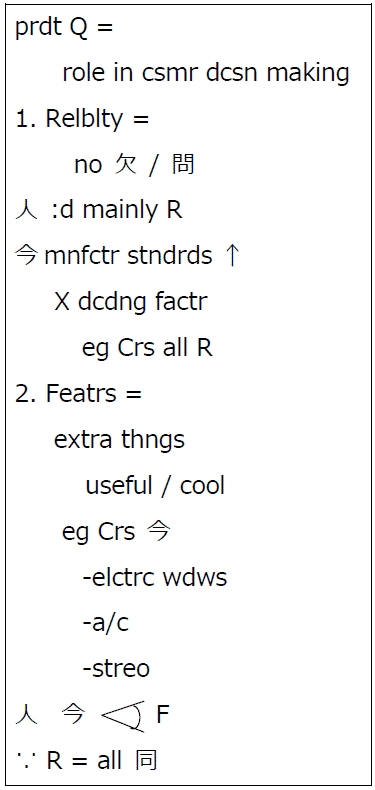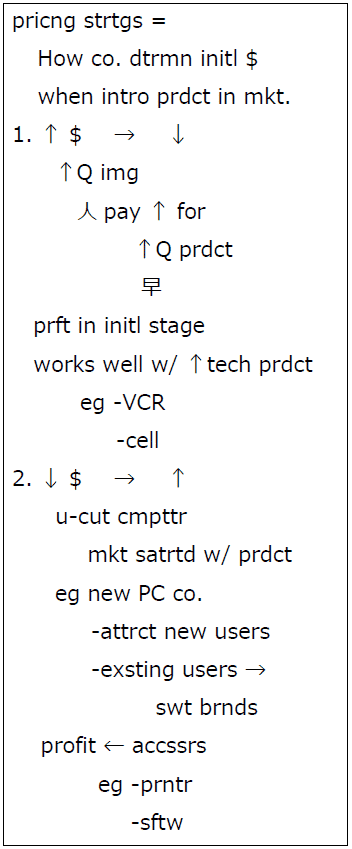スピーキングのQuestion 4 で、いい点を取るコツはあるのかな。どんな対策をすればいい?簡単な答え方手順みたいなの無いかなあ?
このような疑問に答える記事です。
Speaking Section Question 4 の出題形式
Question 4 の問題構成は、(ア)聞いて(イ)話すという形です。
話題は、アカデミックつまり学術的で、大学一回生の授業で扱うような内容です。
自分(テストを受ける人)のすることと時間配分をまとめると、
(ア)大学教授の講義を聞く。2分程度の長さ。
(イ)講義の内容の要点を口頭で説明する。これがレスポンス(解答)。話す内容を考える準備時間20秒、レスポンスを話す時間60秒(Preparation Time: 20 seconds | Response Time: 60 seconds)
この(ア)と(イ)の対策を、例題を使って具体的に検討していきましょう。
例題1
(ア)講義を聞く
例題は、ETSが以前提供していたQuick Prep, vol. 3に含まれているものを使います。
ナレーターの指示
Question 4 が始まると、ナレーターが講義に関する指示を話します。この指示の中に、どういう分野・科目に関する講義なのかという情報が入っています。聞き逃さないようにしましょう。ここで使っている例題の指示は、
Listen to part of a lecture in a business class.
です。この講義は「business」(経営学)の授業ですね。本番では、このような文字情報はありません。音声のみです。
この指示の後すぐに講義が始まるので、この時点で意識を最大限に集中させます。
講義のパターン
Speaking Section Question 4 の講義には、決まったパターンがあります。これを把握しておきましょう。
- 教授は、なんらかの概念(理論)を解説します。何という概念(理論)なのかは、いつも講義の最初の部分(イントロ)で言及します。
- この概念(理論)を解説するために、教授は2つの具体例(要因)を話します。イントロに続く部分で、1つ目の具体例(要因)、そしてその次の部分で、2つ目の具体例(要因)を説明します。
教授が解説している概念(理論)は何か、そして2つの具体例(要因)が何と何なのかということを、講義を聞きながらメモに取るのは賢明ですね。可能であれば、ある程度詳しい情報も書きとめましょう。(ただし、書くことに気を取られて英語が頭に入ってこないという場合は、聞く方を重視します。)
それでは、講義です。
講義のスクリプト
If a consumer has to choose between two products, what determines the choice? Assume that someone, a purchaser, is choosing between two products that cost the same. OK? If people have a choice between two identically priced products, which one will they choose? They choose the one they think is of higher quality, of course. But what does it mean for a product to be a high-quality product? Well, business analysts usually speak of two major factors of quality — one factor is reliability, and the other is what we call features.
So, reliability. What’s reliability? Well, a product is reliable if it works the way we expect it to work, if it can go a reasonable amount of time without needing repairs. If a product, a car for example, doesn’t work the way it should and needs repairs too soon, we say it’s unreliable. So product reliability means, basically, the absence of defects or problems that you weren’t expecting. It used to be that when people thought about product quality, they thought mainly about reliability. Today it’s different. People do still care about reliability, don’t get me wrong. It’s just that manufacturing standards are now so high that … take cars for example; today, today’s cars are all very reliable. So reliability is important, but it’s not gonna be the deciding factor.
So if reliability isn’t the deciding factor any more, what is? Features — all those extras, the things a product has that aren’t really necessary but that make it easier to use or that make it cool: for example, new cars today are loaded with features like electric windows, sun roofs, air conditioning, stereos, and so forth. When people are comparing products today, they look at features — because reliability’s pretty much equal across the board. And that’s why manufacturers include so many features in their products.
メモ
メモの一例を掲載します。メモは、あくまでも、自分がそれを見て分かれば良いので、これは正しいとか間違いだというようなものではありません。これは単に、ご参考までにどうぞ。(メモの書き方に関してはこちら。)

講義内容の分析
上の講義のパターンにもとづいて講義の内容を分析し把握しましょう。
- 教授が説明している「概念(理論)」は消費者が物を買うときの判断材料としての product quality (品質)。
- 「2つの具体例(要因)」は、reliability(信頼性)と features(装備・特徴)。これらについての詳細な情報としては、
- 以前は、製品の品質といえば信頼性(欠陥や問題がないこと)で、それが主な意思決定の要因だったが、現在は決定的な要因ではなくなってきている。なぜなら、どの製品も非常に信頼できるように作られているから。車はよい例だ。
- 今日では、装備・特徴が重要になってきている。これらは製品の利便性を高めたり魅力的にするもの。車で言うと、サンルーフ、エアコン、ステレオなど、たくさん装備されている。消費者は、こういった装備などを主な判断材料としている。信頼性は、どの製品も大差ない。
(イ)レスポンスを話す
教授の講義が終わると、すぐにナレーターが設問を読み上げます。ヘッドホンから聞こえてくると同時に画面にも表示されます。レスポンス(解答)の時間が終わるまで画面に残っています。
Using points and examples from the lecture, explain the two major factors of product quality and how their role in consumer decision making has changed.
画面には、準備時間20秒・解答時間60秒という情報も表示されます。
Preparation time: 20 seconds.
Response time: 60 seconds.
レスポンスの具体的な手順
1準備
まず20秒で何を話すか考えます。
講義を聞いているときに書き留めたメモを利用して、自分がしゃべるレスポンスの要点を整理するのが賢明でしょう。
2 レスポンスを話す
60秒でレスポンスを話します。注意すべきことは、持ち時間は60秒だけ、そして、教授が説明した「概念(理論)」と2つの「2つの具体例(要因)」を必ずしゃべるということです。これらを含めないと、減点されます。
では具体的な手順です。
(1)まず、教授が解説した「概念(理論)」を端的に説明します。たとえば、このように説明できます。
(2)次に、「2つの具体例(要因)」の1つ目について話す。たとえば。
(3)その次に「2つの具体例(要因)」の2つ目について話す。たとえば。
以上です。
例題2
では、もう一つ別の例題を使ってレスポンスの仕方を見ていきましょう。
ETSが以前提供していた Quick Prep, vol. 1 に含まれている問題です。
(ア)講義を聞く
ナレーターの指示
まず、講義に関する指示です。どういう分野・科目に関する講義なのでしょうか。
Now listen to part of a lecture in a business class.
2つ目の講義も「business」(経営学)の授業ですね。
この指示の後すぐに講義が始まります。
講義のパターン
講義のパターンのおさらいです。
- 教授はなんらかの概念(理論)を解説します。何という概念(理論)なのかは、いつも講義の最初の部分(イントロ)で言及します。
- この概念(理論)を解説するために、教授は2つの具体例(要因)について話します。イントロに続く部分で、1つ目の具体例(要因)、そしてその次の部分で、2つ目の具体例(要因)を説明します。
教授が解説している概念(理論)は何か、そして2つの具体例(要因)が何と何なのかということを、講義を聞きながらメモしましょう。
講義のスクリプト
Today, we’ll talk about how companies determine the initial price for their products. By that I mean, when they first introduce a product in the market. There are different approaches, and today we’ll discuss two of them. They are quite different, each with their own advantages.
One approach or strategy sets the initial price of the product high, followed by a lower price at a later stage. Why? Well, when introducing a new product, companies want to build a high-quality image for it. Products that cost more are believed to be of higher quality. So, during the early stages of the product life cycle, companies can make very high profits from consumers willing to pay more for a high quality product, and although consumers know that prices will eventually go down, they’re also willing to pay more to get the product sooner. This approach works very well with … oh … innovative, high-tech products, for example. Now just think about when video recorders, or … video cameras … or even cell phones … first came out. They were very expensive, but then they became much more accessible.
Another very common strategy sets an initial price low. Now this happens when the market is already saturated with the product, and the strategy is to undercut its competitors. Say, there’s a newly starting computer maker trying to gain market share. So what do they do? Well, they offer a computer at an affordable price, lower than existing brands. By doing this, the company appeals to new consumers who weren’t probably even interested in getting a computer and … well, of course … to existing consumers who might now be tempted to switch brands. Now, how does this company make profits with its low-priced computer? Well, one thing that’s often done is to encourage their customers to buy accessories also manufactured by them, like printers, or software, for example.
メモ
メモの一例を掲載します。ご参考までに。(メモの書き方に関してはこちら。)

講義内容の分析
上の講義のパターンにもとづいて講義の内容を分析し把握しましょう。
- 教授が解説している「概念(理論)」は製品を初めて市場に出す際の価格設定戦略(pricing strategies)。
- 「2つの具体例(要因)」は、
- 当初価格を高く設定して製品が高品質だというイメージを与える。幾分高くても、高品質の製品を買う人もいる。いずれ価格が下がると分かっていても速く手に入れたい消費者もいる。初期段階で利益を確保する。この戦略は、革新的なハイテク製品などに適している。例えば、ビデオカメラや携帯電話も当初は高価だった。
- 2つ目の戦略は、当初価格を安く設定して競争力を高める。例えば、パソコン市場がすでに飽和状態のとき、新たに参入するパソコン・メーカーは、低価格製品を売りだして、これまでパソコンを持っていなかった人をターゲットにしたり、既存のユーザーに新たなメーカーのユーザーになるよう促す。利益は、プリンターやソフトなど周辺機器や付属品を売ることで確保する。
(イ)レスポンスを話す
教授の講義が終わると、すぐにナレーターが設問を読み上げます。ヘッドホンから聞こえてくると同時に画面にも表示されます。レスポンス(解答)の時間が終わるまで画面に残っています。
Using the points and examples from the lecture, explain the two pricing strategies described by the professor.
画面には、準備時間20秒・解答時間60秒という情報も表示されます。
Preparation time: 20 seconds.
Response time: 60 seconds.
レスポンスの具体的な手順
1準備
まず20秒で何を話すか考えます。
講義を聞いているときに書き留めたメモを利用して、自分がしゃべるレスポンスの要点を整理するのが賢明でしょう。
2 レスポンスを話す
60秒でレスポンスを話します。注意すべきことは、持ち時間は60秒だけ、そして、教授が解説した「概念(理論)」と2つの「2つの具体例(要因)」を必ずしゃべるということです。これらを含めないと、減点されます。
では手順です。
(1)まず、教授の解説した「概念(理論)」を端的に説明します。たとえば、このように言えます。
(2)次に、「2つの具体例(要因)」の1つ目について話します。たとえば。
(3)その次に「2つの具体例(要因)」の2つ目について話します。たとえば。
実践練習
それでは、音声を使って上の例題1に取り組んでみましょう。まず、メモを取る準備をしてください。下に講義の音声ファイルがあります。この音声ファイルには、講義に続いて、設問も含められています。
設問は次の通りです。
Using points and examples from the lecture, explain the two major factors of product quality and how their role in consumer decision making has changed.
Preparation Time: 20 seconds
Response Time: 60 seconds
20秒でレスポンスを考えて、60秒で話してみましょう。
* * * * * *
いかがでしたか。
一度だけでなく、同じ教材を使って何度か練習してみましょう。コツがつかめると思います。
* * * * * *
以上が、Question 4 得点アップの方法です。
* * * * * *
★ ところで、TOEFL 必須語彙のおすすめ教材をこちらで紹介しています。ご覧ください。



